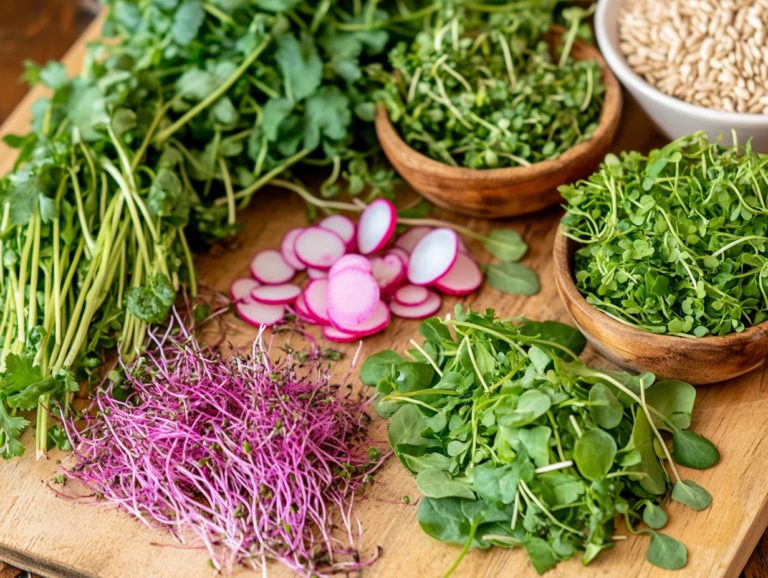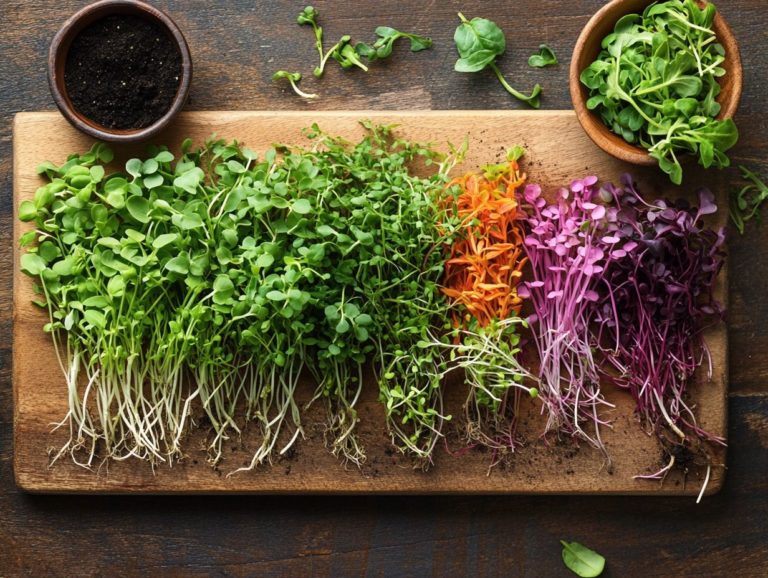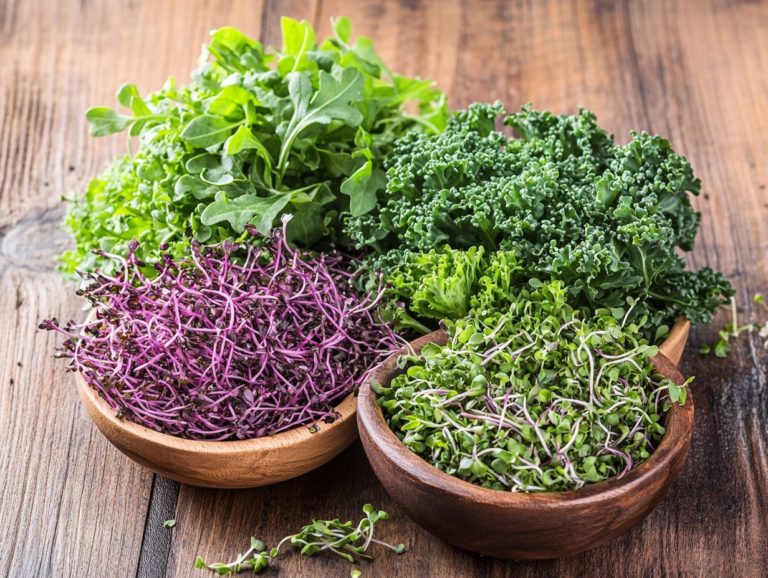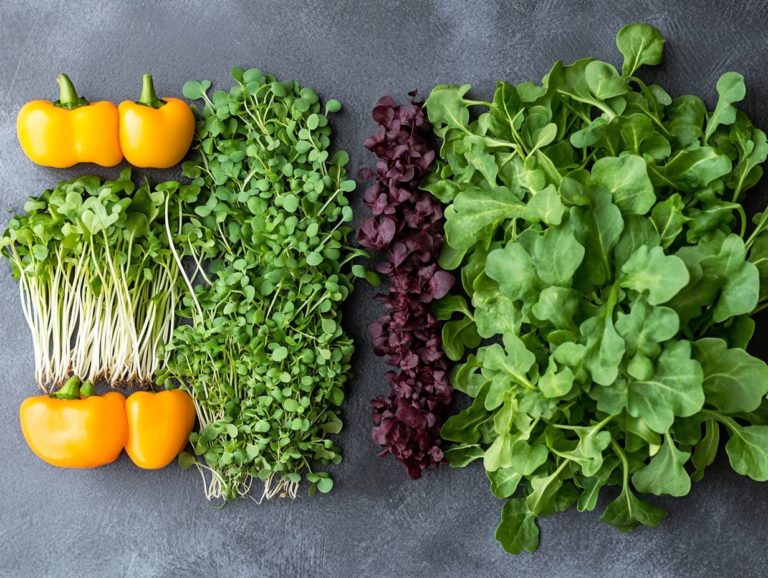The Power of Microgreens in a Balanced Diet
Microgreens are tiny edible plants that pack a punch in flavor and nutrients. They make an essential addition to any balanced diet.
These vibrant young vegetables brighten your meals. They also serve as a concentrated source of vitamins, minerals, and antioxidants.
Explore the myriad nutritional benefits of incorporating microgreens into your diet. From enhancing nutrient intake to supporting gut health, they are a great choice.
Learning how to grow them at home is rewarding. It opens up a world of culinary creativity!
Contents
- Key Takeaways:
- What are Microgreens?
- Benefits of Incorporating Microgreens in Your Diet
- How to Grow and Use Microgreens
- Creative Ways to Incorporate Microgreens in Meals
- Choosing the Right Microgreens for Your Needs
- Popular Types of Microgreens and Their Benefits
- Final Thoughts on Microgreens
- Frequently Asked Questions
- What are microgreens and what makes them powerful in a balanced diet?
Key Takeaways:
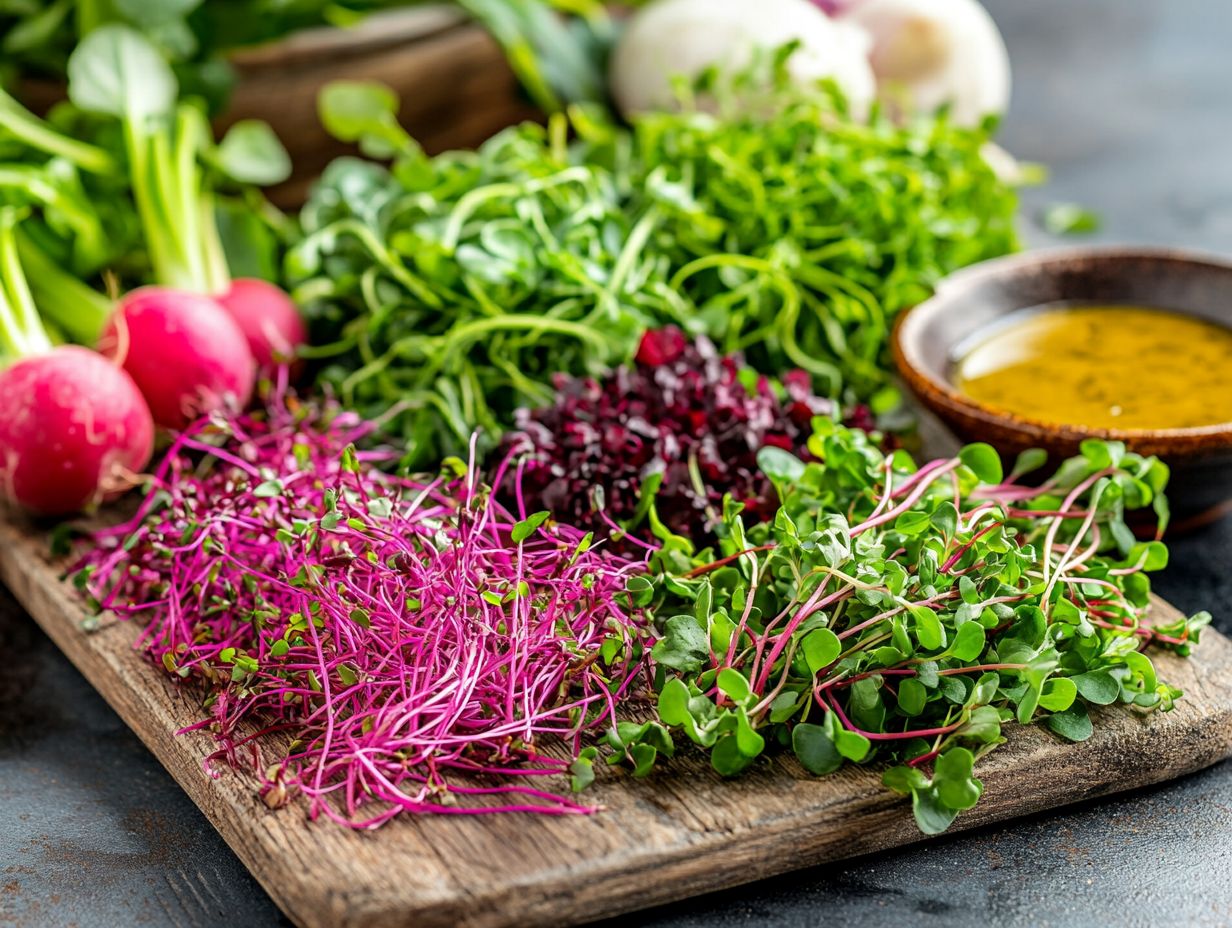
- Microgreens are young, rich in nutrients plants that can provide a powerful boost to your overall health and well-being, making them a staple in a low-fat diet.
- Including microgreens in your diet can increase your nutrient intake, aid digestion, and reduce the risk of chronic diseases.
- Growing and using microgreens is easy and versatile, making it a convenient addition to a balanced diet filled with healthy foods. Choose from a variety of types to best suit your needs and preferences.
What are Microgreens?
Microgreens are young vegetables harvested at an early stage, usually within 7 to 21 days after germination. These little powerhouses not only look fantastic but also deliver remarkable health benefits, packing concentrated nutrients that outshine their fully grown counterparts.
Rich in vitamins, minerals, and phytochemicals, microgreens can elevate your meals, enhancing both flavor and health. Popular varieties like broccoli, Swiss chard, and red cabbage, which belong to the Brassicaceae family, each bring unique tastes and health-promoting compounds to the table. For example, understanding the antioxidant capacity of microgreens can help you appreciate their role, making them a superb addition to your balanced diet.
Benefits of Incorporating Microgreens in Your Diet
Incorporating microgreens into your diet can unlock a wealth of health benefits, providing concentrated nutrients that significantly enhance your overall well-being. These petite powerhouses are packed with vitamins and minerals, making them an exceptional addition to a balanced diet.
Research suggests that microgreens may play a role in cancer prevention, combatting insulin resistance, and lowering the risk of heart disease, particularly due to their rich antioxidant properties. They also support eye health and can effectively address issues like iron deficiency. This makes them a nutrient-rich choice for anyone eager to improve their nutrition, especially considering the science behind microgreens and health.
Boosting Nutrient Intake
Microgreens offer an exceptional opportunity to elevate your nutrient intake, packed with a rich concentration of vitamins, minerals, and potent antioxidants. By incorporating these vibrant greens into your daily meals, you enhance your essential nutrient consumption, effortlessly aligning with dietary recommendations.
These tiny powerhouses are particularly abundant in vitamins A, C, and K each crucial for maintaining various bodily functions. For example, vitamin A champions eye health and bolsters your immune system, while vitamin C is a key player in collagen production, helping to fortify your defenses. Meanwhile, vitamin K is essential for bone health and effective blood clotting, with additional benefits from lutein for overall well-being.
Research suggests that microgreens can boast nutrient levels up to 40 times greater than their full-grown counterparts. This makes them an incredibly efficient means of enriching your overall diet. A study published in Scientific Reports underscored the remarkable nutrient density of microgreens like kale, radish, and amaranth, firmly establishing their rightful place on your plate. For those looking to enhance their diet, exploring the top 10 microgreens for nutritional boost can be beneficial.
Don t wait! Start adding microgreens to your meals today and unlock their amazing benefits!
Improving Digestion and Gut Health

Incorporating microgreens into your diet can enhance your digestion and gut health. They are rich in plant-based compounds and dietary fibers.
These young vegetables serve as a gentle remedy for gastrointestinal discomfort. They foster a healthier digestive system.
Varieties like broccoli, kale, and radish microgreens are loaded with fiber. Fiber is essential for improving digestive health by promoting regularity and nurturing gut flora.
These tiny nutritional gems stimulate the activity of digestive enzymes. This makes it easier for your body to break down food and absorb nutrients.
You can enjoy them raw in salads, sandwiches, or s smoothies. Alternatively, you can lightly cook them in stir-fries and soups, offering delightful versatility in your meal preparation. By weaving these nutrient-dense microgreens into your daily meals, you enrich your diet while actively supporting your digestive wellness. For more information, check out the role of microgreens in healthy eating.
Reducing Risk of Chronic Diseases
Microgreens are packed with potent antioxidant properties that can significantly reduce your risk of chronic diseases, including heart disease and cancer. These vibrant young vegetables are rich in phytochemicals, which are natural compounds that help protect your body from oxidative stress and inflammation.
Research has shown that specific antioxidants found in microgreens like vitamins C and E, along with various polyphenols play a vital role in disease prevention. For example, studies indicate that varieties such as broccoli, radish, and beet microgreens are particularly effective in tackling insulin resistance, an essential factor in managing diabetes.
Their rich omega-3 fatty acid content promotes heart health.
Not only do these nutrient-dense plants enhance your dietary variety, but they also add a delicious, health-boosting element to your meals. This makes it easier for you to incorporate powerful nutrients into your diet effortlessly.
How to Grow and Use Microgreens
Growing microgreens at home is fun and rewarding. You ll create fresh, organic greens right in your kitchen!
By following a few straightforward steps, you can effortlessly cultivate a variety of microgreens right in your kitchen or garden. Ensure a steady supply of these nutritious delights, including varieties like fenugreek and broccoli, while also exploring unlocking the antioxidant power of microgreens.
Step-by-Step Guide to Growing Microgreens
To successfully grow microgreens, follow this comprehensive guide from selecting seeds to harvesting your greens. Start by choosing organic seeds, such as broccoli or amaranth, and create the right growing conditions.
Prepare the soil with a light, well-draining mix that retains moisture while allowing for adequate air circulation. Depending on the species you choose, microgreens generally thrive in a pH range of 6.0 to 7.0.
Water consistently but avoid overdoing it; misting works best until the seeds germinate. Light is paramount aim for 12 to 16 hours of bright, indirect sunlight, or opt for grow lights to promote robust growth.
Keep an eye out for common pests like aphids and fungus gnats. Use natural remedies such as neem oil or insecticidal soap to effectively manage any infestations. With careful attention to these details, you ll be well on your way to enjoying a bountiful harvest of nutritious microgreens.
Creative Ways to Incorporate Microgreens in Meals
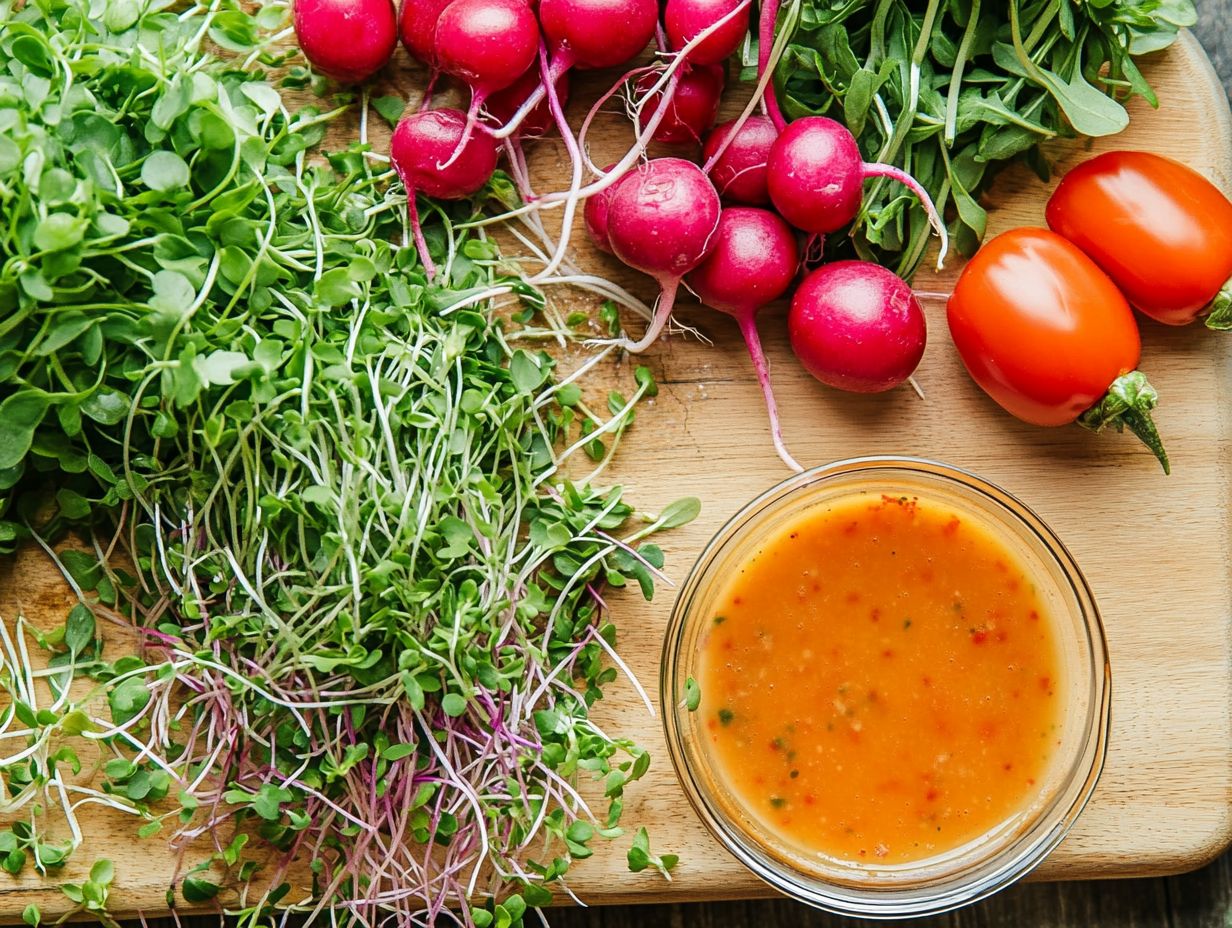
Incorporating microgreens into your meals is effortless and a delightful way to enhance the visual appeal and nutritional value of your dishes. These tiny greens add wonderful flavor and texture to salads, sandwiches, and smoothies, making them a versatile addition to your cooking options.
Imagine using pea shoots in a refreshing Asian-inspired stir-fry, where their sweet, crisp texture perfectly complements the umami richness of soy sauce and sesame oil. If Mediterranean cuisine is more your style, a sprinkle of basil microgreens can transform a simple Caprese salad, infusing it with a fragrant burst of flavor and showcasing why microgreens are essential for a balanced diet.
For those who follow a plant-based diet, sunflower and radish microgreens offer an excellent protein boost, making them ideal toppings for grain bowls or veggie burgers. With so many options available, you can easily find a microgreen that matches any culinary preference, whether it’s a zesty lime microgreen enhancing your tacos or kale microgreens enriching your morning smoothie. Understanding the role of microgreen varieties can further elevate your plant-based meals.
Choosing the Right Microgreens for Your Needs
Selecting the ideal microgreens requires understanding the diverse varieties available and their distinct nutritional benefits. From nutrient-packed broccoli microgreens to the delightful flavor of amaranth, each type offers unique health advantages that can complement your diet goals.
Popular Types of Microgreens and Their Benefits
Among the popular types of microgreens, you ll find broccoli, fenugreek, and red cabbage standing out due to their exceptional nutritional benefits. These varieties not only add vibrant colors to your dishes but also deliver essential nutrients that can significantly enhance your health.
Take broccoli microgreens, for example. They’re packed with sulforaphane, a compound linked to reducing cancer risks, with studies suggesting it may help lower tumor growth. Fenugreek microgreens also shine; they are rich in iron, potassium, and antioxidants, all of which support digestion and can improve heart health. Additionally, learning more about why microgreens are superfoods you need can enhance your understanding of their benefits.
Then there are red cabbage microgreens, known for their anthocyanins, which are natural pigments that help reduce inflammation. These microgreens can be easily added to salads, sandwiches, or used as garnishes, combining deliciousness with nutritional benefits.
Research supporting these claims highlights their exceptional nutritional profiles, providing strong evidence for incorporating them into your balanced diet.
Final Thoughts on Microgreens
Microgreens are a nutritious addition to your diet, offering many health benefits that can significantly enhance your overall well-being. With their concentrated nutrients, antioxidants, and vibrant flavors, they are perfect for various culinary applications from fresh salads to elegant garnishes.
Beyond adding color and flavor to your meals, these young plants are rich in vitamins A, C, and K, which support immune function and promote healthy skin. By incorporating microgreens into your dishes, you not only boost your nutrient intake but also support a balanced diet that can help with weight management and reduce the risk of chronic diseases. For health enthusiasts, exploring the top microgreen varieties can enhance your culinary experience.
Their ease of growth and adaptability in both home gardens and urban environments further highlight their potential as sustainable food sources. Ultimately, embracing microgreens is a delightful way to nourish your body while enjoying diverse culinary experiences.
Frequently Asked Questions
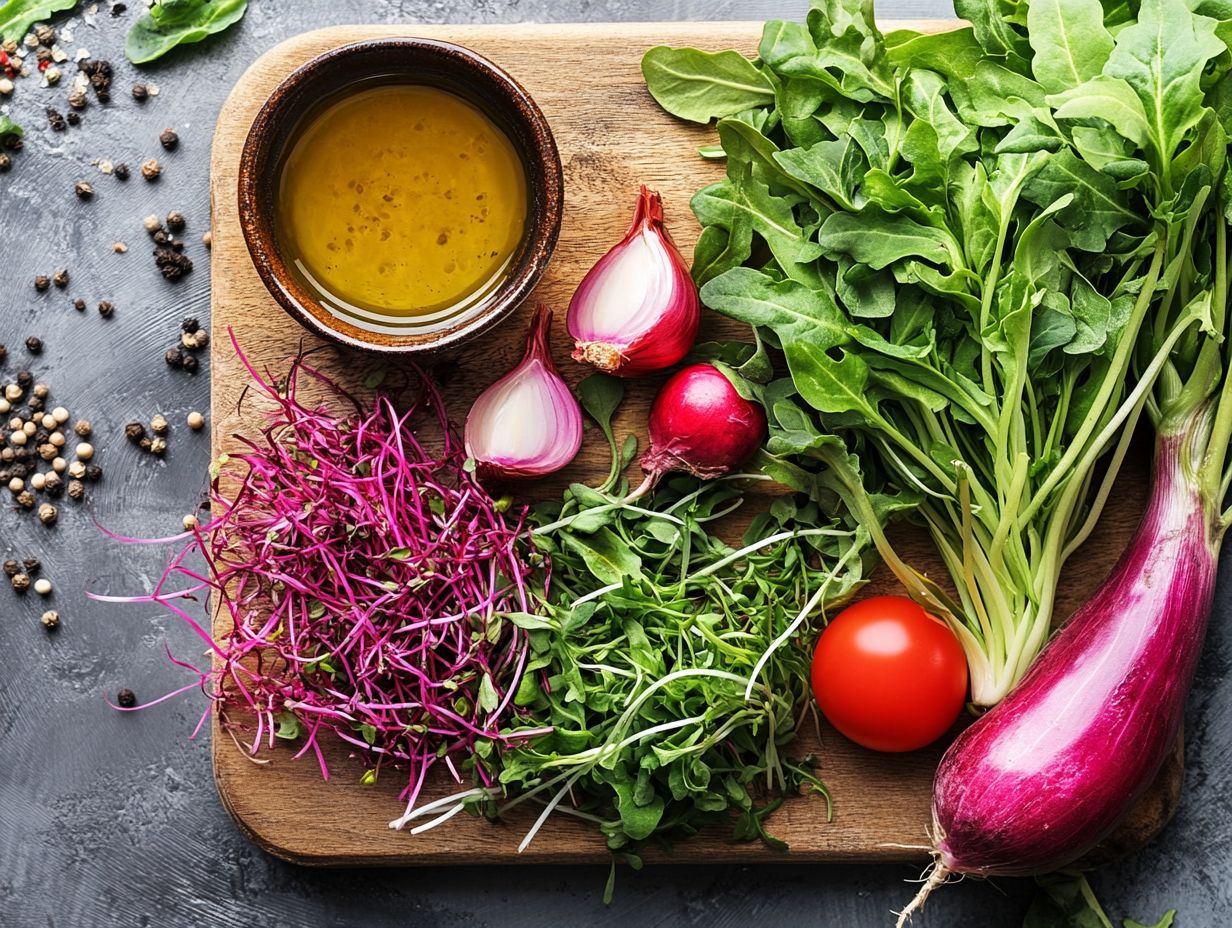
What are microgreens and what makes them powerful in a balanced diet?
Microgreens are young vegetable greens that are harvested after the first true leaves have developed. They are packed with nutrients and phytochemicals, making them a powerful addition to a balanced diet.
How do microgreens compare to mature vegetables in terms of nutrition?
Studies show that microgreens can contain up to 40 times more nutrients than mature vegetables. They are harvested when young, allowing nutrient levels to peak.
What nutrients can be found in microgreens?
Microgreens are packed with a variety of nutrients. They include vitamins, minerals, and antioxidants. Common nutrients found in microgreens are vitamins A, C, and K, along with iron, potassium, and magnesium.
You’ll also find beneficial compounds like polyphenols, which help protect your body, carotenoids that are great for eye health, and flavonoids known for their antioxidant properties.
How can microgreens contribute to a balanced diet?
Including microgreens in your meals boosts your intake of essential nutrients. They also add variety and enhance the visual appeal of your dishes.
Start adding microgreens to your meals today for a health boost!
Can anyone incorporate microgreens into their diet?
Absolutely! Microgreens are suitable for everyone, regardless of age or dietary preferences. They’re also easy to grow at home. You’ll be amazed at how simple it is!
Are there any precautions to keep in mind when consuming microgreens?
Microgreens are generally safe, but remember to wash them thoroughly to minimize contamination risks. If you’re allergic or sensitive to specific types, it’s best to avoid them.

